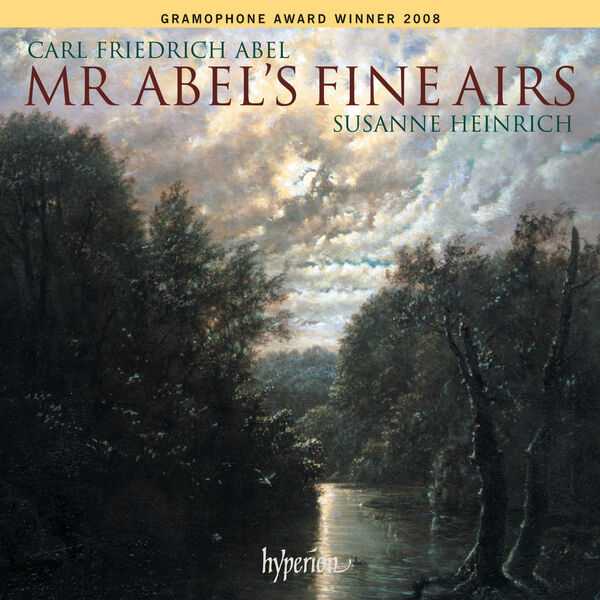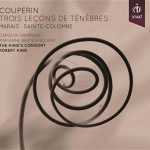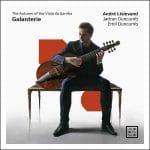
Composer: Carl Friedrich Abel
Performer: Susanne Heinrich
Format: FLAC (tracks)
Label: Hyperion
Catalogue: CDA67628
Release: 2007
Size: 348 MB
Recovery: +3%
Scan: yes
Mr Abel’s Fine Airs
01. Adagio, AbelWV A8
02. Vivace, AbelWV A9
03. [Allegro], AbelWV A11
04. Tempo minuetto, AbelWV A2
05. Adagio, AbelWV A30
06. [Arpeggio], AbelWV A26
07. [Tempo di menuet con variazioni], AbelWV A24
08. [Moderato], AbelWV A29
09. [Adagio], AbelWV A6
10. Fuga, AbelWV A16
Sonata in G Major
11. I. Adagio, AbelWV A3
12. II. Allegro, AbelWV A3
13. III. Tempo di menuet, AbelWV A1
14. IV. Adagio, AbelWV A4
15. Allegro, AbelWV A18
16. Tempo di menuet, AbelWV A23
17. Andante, AbelWV A10
18. [Arpeggio], AbelWV A14
19. Allegro, AbelWV A28
20. Tempo di menuet, AbelWV A7
21. [Andante], AbelWV A19
22. [Allegro], AbelWV A15
23. Allegretto, AbelWV A32
24. Allegro, AbelWV A33
Carl Friedrich Abel (1723–1787) was a contemporary of J C Bach, and a fashionable performer and promoter in London in the eighteenth century. By that time the viola da gamba was a rarity, but Abel’s performances sparked a revival of interest among performers and audiences. The works recorded on this disc (six of which have never been previously recorded) can be seen as musical expositions of sensibility, inhabiting the same tragic world as the gamba solos in J S Bach’s Passions. Abel’s contemporary Charles Burney commented on the musician’s ability to ‘breathe’ the notes as he played them, and this extraordinary sensitivity is present too in the beautiful playing of Susanne Heinrich.
Carl Friedrich Abel’s most frequently recorded repertoire heretofore would include what remains of his symphonies, concerti — mostly those for the flute — and a smattering of chamber sonatas, many of them also for flute. While Abel did not compose operas apart from a few inserts, his surviving music is heavy with items originating from an expansionist and professional area of his talent; works written to fill the bill on concerts, for to accommodate published sets and the like. Abel’s contemporaries, though, are in uniform accord in remembering him that his greatest achievements were not witnessed in the concert hall, but in the late evenings at private homes, performing on his main instrument — the viola da gamba — for a few friends. With Susanne Heinrich’s Hyperion disc Mr. Abel’s Fine Airs we are finally accorded a substantive glimpse of the private side of Abel, and it is telling.
Of Abel’s output for solo gamba, nearly 80 pieces survive, though the majority of these are relatively simple works intended for teaching purposes; most don’t even bear tempo indications. Heinrich, of the ex-Palladian Ensemble now Palladian Trio, has selected 24 movements from about 30 that are more ambitious and not obviously oriented to pedagogical purposes. The result is a rich and highly varied program that puts to the test Walter Knape’s assertion that Abel’s music was “a refined, urbane version of the Mannheim style with perhaps an Italian influence in the more vocal melodies.” There are many instances among these solo pieces where Abel leaves the galant mannerisms of his era aside in music reminiscent of the late Baroque — the world of Johann Sebastian Bach, Sylvius Leopold Weiss, and Marin Marais. Although some of these mostly un-datable pieces may actually have originated from before 1755 when Abel is believed to have left Germany for London, others may be late reflections on the Baroque solo idiom, not unlike the solo cello pieces of Joseph-Marie-Clément Dall’Abaco lately recorded by Kirstin von der Goltz, which date from around 1760 or later. The Adagio WKO 209 puts Knape on the fence over his assertion that there “is little trace of deeper emotion or Sturm und Drang” in Abel — it is all that and more. This recital is jam-packed with compositional devices that conventional wisdom tells us Abel did not use and pieces that are but more reserved in style, Heinrich brings a remarkable flexibility and fluidity of expression, accentuating what Burney called “[Abel]’s discretion [and] taste [in]…breathing a few notes.”
All of these pieces are intensely personal and played with discipline, respect, and yet a sense of freedom by Heinrich — exactly the traits Abel’s friends so admired in his own playing. There is no doubt that Abel was the last of the great viola da gamba players before the instrument went into a period of a century and a half of dust and silence; but until Mr. Abel’s Fine Airs we have experienced little first-hand evidence of what his artistry might have been like. Mr. Abel’s Fine Airs is an urgently important release in a historical sense and a very satisfying one for general listening purposes; while gamba fanciers and enthusiasts of eighteenth century music will love it the most, it’s hard to imagine any lover of great music not wanting to experience it; Hyperion’s Mr. Abel’s Fine Airs is very “fine” indeed.



